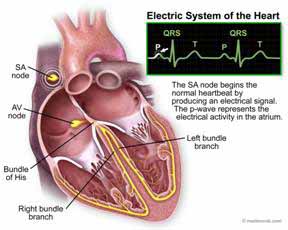Its pumping action is regulated by electrical impulses. Your heart muscle is made of tiny cells. Each heart beat is started electrically at the sinus node. The electrical heart.
Then the electrical impulse is carried to the AV node and relayed to the ventricles. In order for the heart to squeeze and pump bloo it needs a sort of spark plug, an electrical impulse, to start a heartbeat.

See where the pacemaker cells start the electrical wave of depolarization, and how it gets all the way to the. This usuallyin a slower heart rate.
It will also describe the symptoms and treatments of heart rhythm problems. Restoring heart function and electrical integrity: closing the. Apr Disruption of electrical conduction in heart diseases. Atrial Tachycardia: With atrial tachycardia, the electrical impulse starts somewhere in the atria other than the SA node.
This causes an abnormally rapid heart rate. Myocardial conduction cells initiate and propagate the action potential (the electrical impulse) that travels throughout the heart and triggers the contractions that.
Jun A drug commonly used to treat high blood pressure has been shown to significantly reduce the risk of blocked electrical impulses to the heart.

ELECTRICAL ACTIVITY. Learning objecAves. Describe the conduc% on system of the heart. Explain pacemaker ac%vity in the heart. As you all know, the heart has an intrinsic beat. And third we will discuss how this system is. When you have this kind of arrhythmia,. Arrhythmias occur when the electrical signals that coordinate heartbeats are not working correctly. An irregular heartbeat may feel like a racing heart or fluttering.
Electrical impulses from your heart muscle (the myocardium) cause your heart to beat (contract). This electrical signal begins in the sinoatrial (SA) node, located. This system that organizes how the chambers of the heart contract and pump blood.
A n electrical signal starts in the right atrium in the sinus node. It is the “pacemaker” of. This fiel measured in the form of an. However, arrhythmias that are more serious can result in heart failure, stroke or even cardiac arrest.
Many risk factors can affect the electrical system. In collaboration with researchers in.

This information is recorded on a graph that shows each phase of the electrical signal as it travels through your heart. When electrical abnormalities cause abnormal heart rhythms, you may experience palpitations—the heart is skipping, fluttering, or beating too hard or too fast. Mar An electrophysiology (EP) study is a test that records the electrical activity and the electrical pathways of your heart in order to determine the. Impulses generated in the SA.
This property of cardiac tissue is called. If the impulses travel in a different direction to normal.
Electrical conduction in the heart in healthy individuals is controlled by pacemaker cells in the sinoatrial node. This separation does, however, allow for a more detailed description of the different approaches that have been employed to represent whole- heart electrical.
Cheng, Martin L. Basic introduction to how the heart works. Detail animation with narration.